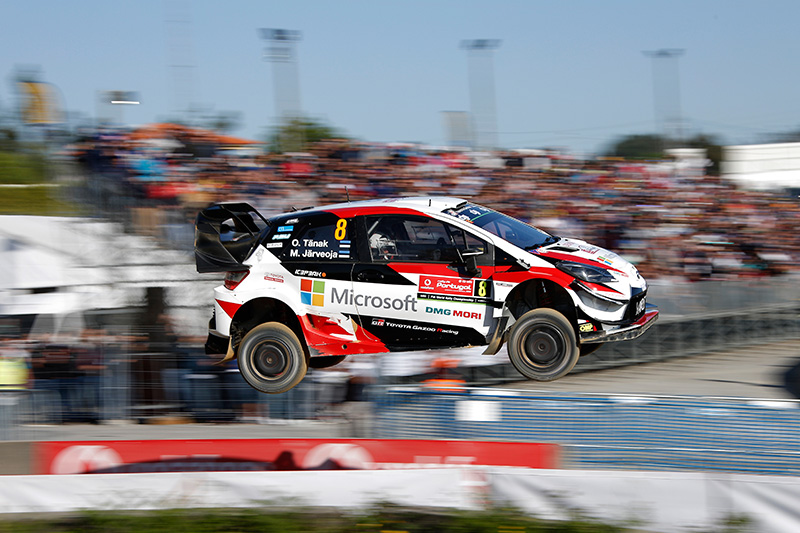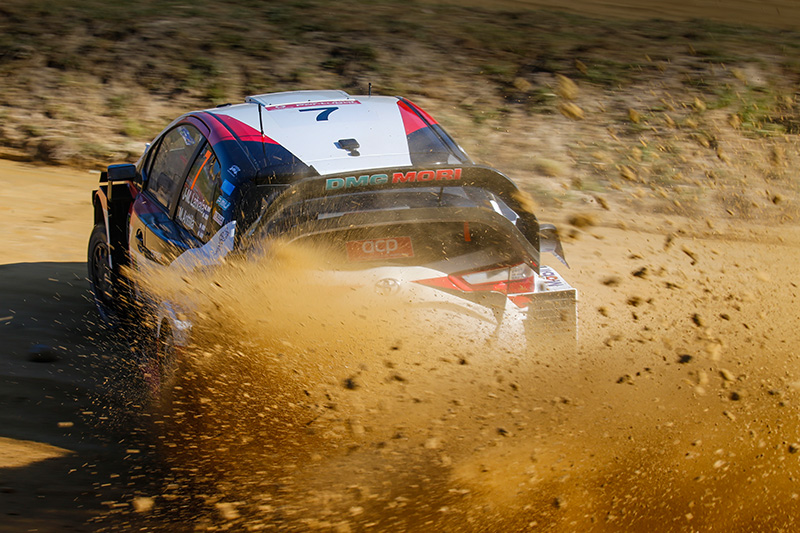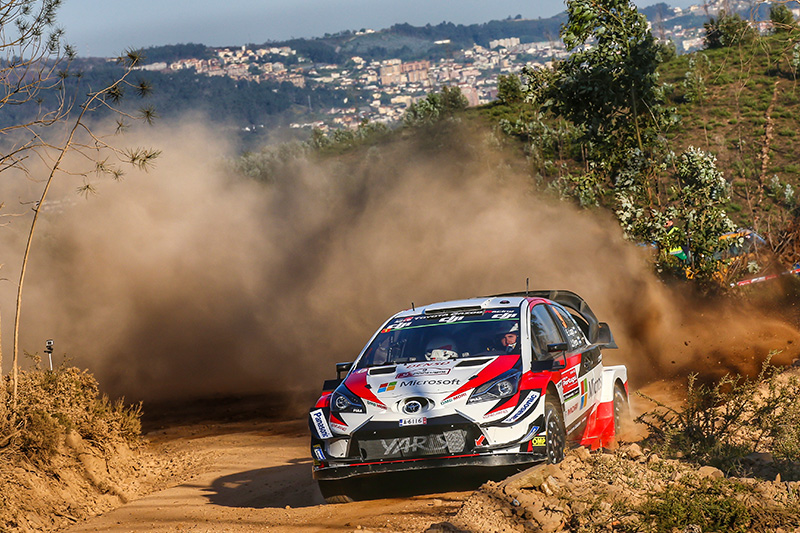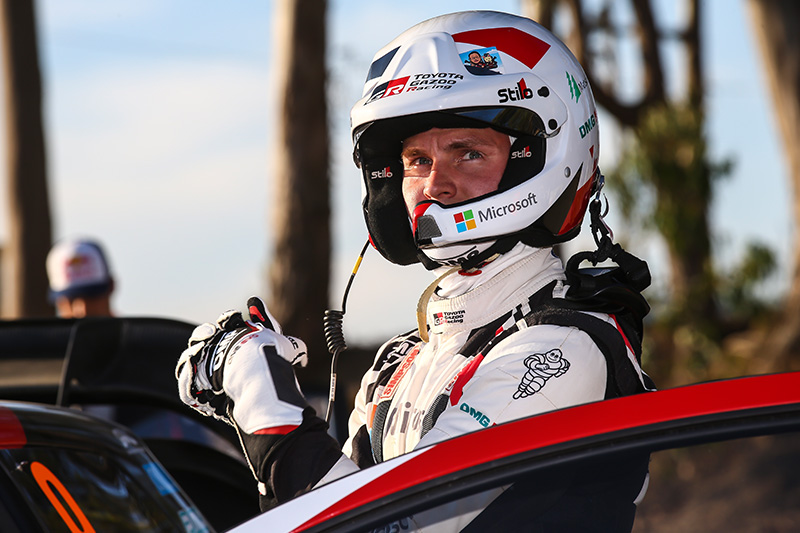RALLY DE PORTUGAL
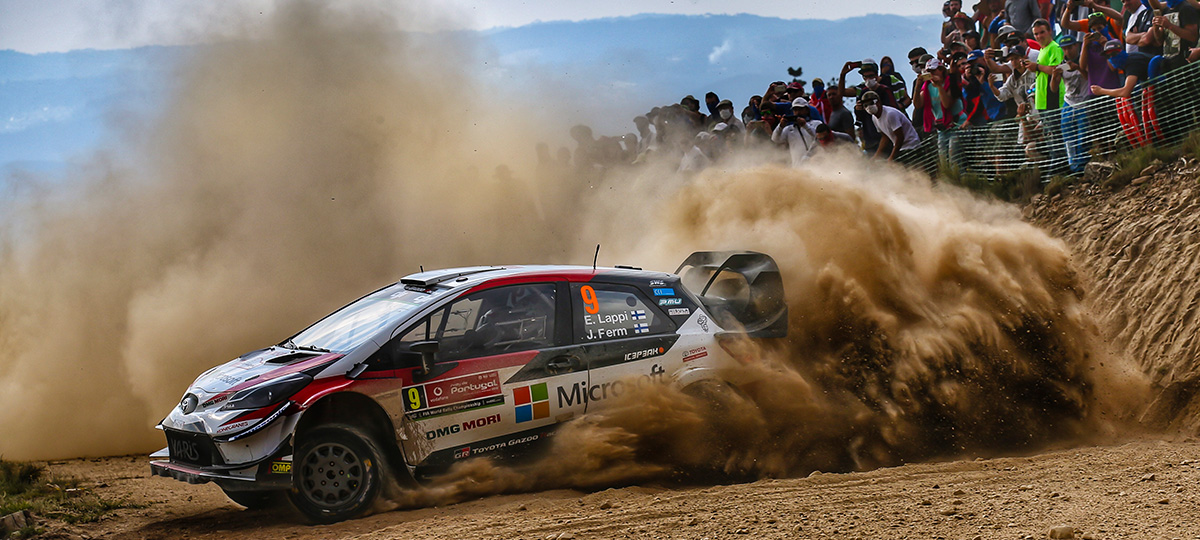
Despite entering the Rally de Portugal confident of victory, TOYOTA GAZOO Racing WRT face unexpected hardships
The team learns the difficulty of optimizing their cars for gravel surfaces that change on a daily basis
Rally de Portugal is regarded as the most “standard” of the WRC gravel rallies: the weather is comparatively mild, while the altitude is not high like at Rally México; the speed on this course is not particularly high nor excessively low; above all else, the gravel surfaces are, on the whole, flat, enabling drivers to enjoy driving. For these reasons, Rally de Portugal has long been seen as a rally at which the true performance of a rally car is thrown in stark relief. The organizers of Rally de Portugal are passionate about preparing high-quality gravel stages and work hard to ensure that the cars can be driven in good conditions. This year, the organizers repaired rough parts of the course resulting in surface conditions that were flatter than ever before. During the recce (an abbreviation of “reconnaissance,” where drivers check out the courses before the start of the rally), the drivers praised the surface conditions: “This year’s stages have been extremely well prepared. In particular, the first full gravel section on Day Two is in exceptional condition.” However, parts of the course had already been broken up at the time of the recce, and concerns about the softness of the road surfaces were expressed.
Tänak and Latvala hit rocks early in the rally
The first day of the rally took place on May 18. Ott Tänak won the opening Super Special Stage, which was set on a rallycross circuit, and so secured first place in the start list. It appeared to be a continuation of the outstanding performance that had seen him win the preceding Rally Argentina. However, on SS2—the opening stage of Day Two—multiple large stones in the cornering line struck the front underside of Tänak’s car. The impact caused cooling liquids to leak from his radiator, damaging his engine, and the Estonian was forced to retire. On SS3, Jari-Matti Latvala drove over a large stone situated on the inside of a corner and damaged his front-right suspension. Unable to continue, he was forced to stop his car out on the course. In the service park, TOYOTA GAZOO Racing World Rally Team repaired the damage to his Yaris WRC, and Latvala was able to rejoin the rally on Day Three. However, the fact that two cars had dropped out from the competition for the podium so early on in the rally was extremely disappointing for the team.
But why did stones cause such major damage to the two rally cars? Following the conclusion of the rally, while noting that “we are still investigating the details,” chief engineer Tom Fowler said: “In Ott’s case, we think that large stones that had been embedded in the ground were dug out to the surface by preceding rally cars. The stones are easily moved since the gravel is soft, and the course becomes increasingly rough, even after just one or two cars have passed over it. In a short space of time, the course conditions changed significantly. Ott was unfortunate that large stones struck the underside of his car and created large impacts. Likewise with Jari-Matti—when he drove over the stones, significant stress was placed on his car’s suspension, resulting in damage. Both incidents can be put down to bad luck; however, we are currently investigating whether there were any issues with the cars. In addition, since similar surface conditions are expected at the next rally, Rally Italia Sardegna, we are currently considering what measures we can implement to prevent this from reoccurring.”
Lappi also struggles on gravel surfaces which, in contrast to last year, are extremely rough
The more the rally cars passed over the roads, the more the surface conditions worsened. Esapekka Lappi, at the wheel of the No.9 Yaris WRC, was unable to hide his surprise at the unexpectedly rough conditions: “The surface conditions during the afternoon stages were among the worst I have ever experienced. They were worse even than Argentina!” Lappi struggled during the morning stages of Day Two, and fell to 11th overall, some 26 seconds behind the leader. The Finn had been confident of challenging for a podium position when he started the rally, so this was an unforeseen setback. However, the primary reason for that was the fact he was unable to feel sufficient grip with his tires, and he was therefore unable to attack as much as he would have liked. Consequently, the team modified his suspension settings during the midday service time. In view of the course conditions, they utilized the same setup that had proved so successful at Rally Argentina. Lappi’s feeling of the car returned, and he managed to improve his speed.
The setup optimized for Rally de Portugal backfires
As to why Lappi struggled during Day Two’s morning stages, Fowler explained: “The gravel stages at Rally Argentina and Rally de Portugal are reasonably similar; but the surfaces are normally rougher in Argentina and smoother in Portugal. As a result, at the pre-rally tests for Rally de Portugal, we experimented with a slightly firmer setup than we had used in Argentina and fine-tuned the cars so that they would move more nimbly and accurately. The drivers were satisfied with this setup during the tests. However, at this year’s Rally de Portugal, the gravel surfaces were both softer and rougher than in previous years. In other words, they more closely resembled the surfaces we experienced in Rally Argentina. Although the stages themselves were almost unchanged, the surface conditions were entirely different to those we had competed on last year. In the end, the fine-tuning we thought would give us an advantage backfired.”
In contrast to circuits which are isolated from the outside world and constantly being managed, rally stages take place on general roads and their conditions change on a daily basis. This is particularly true of gravel stages. Surfaces are damaged by periods of prolonged rain or snow and, even if stones and gravel are mixed in to repair and flatten the surfaces of the roads, eventually the rough surface underneath is exposed. This cycle is accelerated during rallies, when lots of high-power cars race across the surfaces. In addition, the traction provided by the roads changes according to the quality of the gravel and dirt used during repairs. Even though roads might look similar, it happens to be completely different in reality. This was the case at Rally de Portugal this year. Fowler swore to further develop both the cars and the team: “This is our second time at Rally de Portugal, and we lacked knowledge regarding how the surface conditions change. I will most certainly make use of this experience in future rallies.”
Lappi improves his pace after his car’s settings are updated
Faster and more confident after changes to his vehicle settings, on Day Three Lappi further increased in competitiveness. He recorded two top-three SS times and engaged in a hard-fought battle with M-Sport Ford WRT’s Teemu Suninen and Hyundai Shell Mobis WRT’s Dani Sordo for third place. On Day Four, the final day of the rally, Lappi was even quicker, recording top-three times on each of the day’s five SSs. On SS16 and SS20 which was the designated Power Stage, Lappi recorded the fastest times of all. It was a remarkable performance as Lappi himself noted: “I made no major mistakes; I have never attacked so hard for so long.” However, Suninen also performed superbly, and Lappi was thwarted in the seesaw battle for third, eventually finishing in fourth overall.
A stewards’ meeting was held after the rally, and Lappi was retrospectively penalized for touching straw barriers—which had been placed on the Porto Street Stage—on the final SS of Day Two. He received a ten-second time penalty, dropping him to fifth in the overall rankings. However, as a result of securing five bonus points from his victory on the Power Stage—his third of the season—the Finn improved his standing from seventh to fifth in the drivers’ championship.
Latvala secures three stage wins after rejoining the rally
Latvala rejoined the rally on Day Three, in line with Rally 2 regulations, and proceeded to complete Rally de Portugal with no further incidents. Finally showing his true speed, he secured two SS victories on Day Three and a further victory on Day Four. In so doing, he also regained the confidence he had nearly lost following successive retirements in recent rallies. Although he was disappointed with his misfortune in the early stages, Latvala was able to conclude Rally de Portugal in good form. Hopes are high that he will return to his best at the following Rally Italia Sardegna. Tänak, who was forced to retire from the rally before he had an opportunity to demonstrate his real pace, is also expected to go back on the attack in Italy—the scene of his first-ever WRC win in 2017.
The unexpected surface changes at the 2018 Rally de Portugal deceived the team and drivers, meaning they were unable to show the full extent of their capabilities. However, the entire team thereby acquired valuable experience. At Rally Italia Sardegna, the next rally, will the surface conditions change, or will they remain constant? The team is further accelerating development in preparation for the gravel rally, which takes place in approximately three weeks’ time.
RESULT
| Pos | Driver | Co-Driver | Vehicle | Time |
|---|---|---|---|---|
| 1 | Thierry Neuville | Nicolas Gilsoul | Hyundai i20 Coupe WRC | 3h49m46.6s |
| 2 | Elfyn Evans | Daniel Barritt | Ford Fiesta WRC | +40.0s |
| 3 | Teemu Suninen | Mikko Markkula | Ford Fiesta WRC | +47.3s |
| 4 | Dani Sordo | Carlos Del Barrio | Hyundai i20 Coupe WRC | +1m00.9s |
| 5 | Esapekka Lappi | Janne Ferm | Toyota Yaris WRC | +1m04.7s |
| 6 | Mads Ostberg | Torstein Eriksen | Citroen C3 WRC | +3m33.5s |
| 7 | Craig Breen | Scott Martin | Citroen C3 WRC | +5m23.0s |
| 8 | Pontus Tidemand | Jonas Andersson | Skoda Fabia R5 | +14m10.8s |
| 9 | Lukasz Pieniazek | Przemyslaw Mazur | Skoda Fabia R5 | +16m17.3s |
| 10 | Stephane Lefebvre | Gabin Moreau | Citroen C3 R5 | +16m34.3s |
| 24 | Jari-Matti Latvala | Miikka Anttila | Toyota Yaris WRC | +48m50.3s |
| Retired | after day 2 Ott Tänak | Martin Järveoja | Toyota Yaris WRC |

